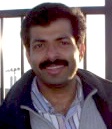
Prof Mahesh Hariharan
Professor (Chemistry)
Mahesh Hariharan Research Group
Physical Organic Chemistry Laboratory
Our research group focuses on various aspects of Physical Organic Chemistry and Biophysical Chemistry to understand the effect of light on organic small molecules and biomolecules. Synthetic efforts to modulate the rate of charge recombination that is monitored using ultrafast spectroscopic techniques is one of the primary interests in our group at IISER TVM. We also look at the strength of weak interactions in novel crystals using theoretical models such as quantum theory of atoms in molecules and exciton migration using cluster model. A combined effort to synthesise novel and diverse architectures, investigate/regulate the ultrafast processes and understand the theoretical reasons behind the events makes our attempt unique.
i) Biophysical Chemistry and Photophysics of Biomolecules: Exciton chirality, energy and electron transfer in DNA is explored to mimic natural photosynthetic system. Our attempts to use multiple charge donors/acceptors in DNA have clearly demonstrated enhanced photoinduced charge transport as compared to naked DNA. Using nano-, pico- and femto-second resolved absorption/emission techniques, we probe ultrafast processes such as energy and exciton migration across these architectures.
ii) Artificial Photosynthesis/Femtosecond Spectroscopy: We design/synthesise small molecule based donor-acceptor systems to enhance the lifetime of photoinduced charge separated states in organic molecules. Preliminary efforts led us to an understanding that organised donor or acceptor in the presence of respective counterpart (acceptor/donor) improves the survival time of charged intermediates. Attempts are in progress to create better architectures/strategies to improve the efficiency of photoinduced charge separation.
iii) Photonic Crystals: Dihydrogen and other weak interactions are utilised to tune the opto-electronic properties in crystals. We explore the rate of exciton diffusion in organic crystals of diverse packing. In summary, our group aims at understanding ultrafast processes in organic structures having diverse nearest neighbour interaction. We utilize a combination of weak interactions such C–H•••H–C, C–H•••O, C-H•••? and Π-Π to create various interplanar angles between the adjacent arenes. Using spectroscopic techniques, we probe ultrafast processes such as energy and exciton migration across these architectures.
- “C–H•••H–C and C–H•••Π Contacts Aid Transformation of Dimeric to Monomeric Anthracene in the Solid State” K. Nagarajan, S. K. Rajagopal and M. Hariharan* CrystEngComm 2014, 16, 8946-8949
- “Progressive Acylation of Pyrene Engineers Solid State Packing and Colour via C–H•••H–C, C–H•••O and ?-? Interactions” S. K. Rajagopal, A. M. Philip, K. Nagarajan and M. Hariharan* Chem. Commun. 2014, 50, 8644-8647 (Inside Frontispiece)
- “Light Harvesting Vesicular Donor-Acceptor Scaffold Limits the Rate of Charge Recombination in the Presence of an Electron Donor” R. T. Cheriya, A. R. Mallia and M. Hariharan* Energy Environ. Sci. 2014, 7, 1661-1669 (Frontispiece; Hot Article)
- “Non-natural G-quadruplex in a Non-natural Environment” S. K. Rajagopal and M. Hariharan* Photochem. Photobiol. Sci. 2014, 13, 157-161 (Nick Turro’s Special Issue)
- “Perylene Polyimide Based Organic Electrode Materials for Rechargeable Lithium Batteries” P. Sharma, D. Damien, K. Nagarajan, M. M. Shaijumon,* and M. Hariharan* J. Phys. Chem. Lett., 2013, 4, 3192–3197 (One of the most read articles)
- “Breakdown of Exciton Splitting through Electron Donor–Acceptor Interaction: A Caveat for the Application of Exciton Chirality Method in Macromolecules” J. Joy, R. T. Cheriya, K. Nagarajan, A. Shaji, and M. Hariharan* J. Phys. Chem. C, 2013, 117, 17927–17939
- “Single Component Organic Light-Harvesting Red Luminescent Crystal” R. T. Cheriya, K. Nagarajan and M. Hariharan* J. Phys. Chem. C, 2013, 117, 3240-3248
- “DNA-Enforced Conformational Restriction of an Atropisomer” R. T. Cheriya, J. Joy, S. K. Rajagopal, K. Nagarajan and M. Hariharan* J. Phys. Chem. C, 2012, 116, 22631-22636
- “Effect of Temperature on Symmetry Breaking Excited State Charge Separation: Restoration of Symmetry at Elevated Temperature” H. Khandelwal, A. R. Mallia, R. T. Cheriya and M. Hariharan* Phys. Chem. Chem. Phys., 2012, 15282-15285
- “Energy Transfer in Near-Orthogonally Arranged Chromophores Separated through a Single Bond” R. T. Cheriya, J. Joy, A. P. Alex, A. Shaji and M. Hariharan* J. Phys. Chem. C, 2012, 116, 12489–12498
